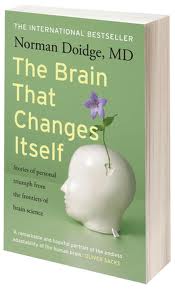 This past Thursday the JB Music Therapy Team were together at their regular team meeting to review The Brain that Changes Itself by Norman Doidge. The lively discussion was a great way for us to connect about our views around the increasing amount of information pertaining to the science of the brain. We as music therapy clinicians need to pay attention to this information in order to translate the science into successful therapeutic practices that can reach the goals of our clients.
This past Thursday the JB Music Therapy Team were together at their regular team meeting to review The Brain that Changes Itself by Norman Doidge. The lively discussion was a great way for us to connect about our views around the increasing amount of information pertaining to the science of the brain. We as music therapy clinicians need to pay attention to this information in order to translate the science into successful therapeutic practices that can reach the goals of our clients.
OUR REVIEW
The Brain that Changes Itself, written by Canadian author Norman Doidge is aimed at anyone who is curious and willing to discover more about their own abilities to learn and change as we age. Dr. Doige through real life accounts illustrates that the brain can rewire itself based on the “use it or lose it” model. He uses many stories to demonstrate this principle.
An import aspect of this book is Doidge’s acknowledgement of neuroscience research and the people behind the research – individuals he holds in apparent high regard as he identifies their work as nothing short of miracles.
Chapters 1 and 2 contain inspirational stories that lure the reader into to the lives of the people behind the stories. Chapter 3 is for people who are interested in becoming smarter by sharpening perception, improving memory and increasing their speed of thought. Chapter 4 discusses the role of neuroplasticity in love and sexual attraction. A couple of therapists commented that this might have been the most surprising of all parts of the book. Chapters 5 and 6 address specific areas where brain plasticity helps people who have sustained serious neurological impairment and Chapter 7 explores the negative side of brain plasticity including brainwashing – the flip side of this is then addressed in Chapter 8.
Science is now clearly articulating that the brain is not so much hard – wired and if anything is vulnerable to its environment. This is one area that Doidge wants the audience to comprehend. The impact of media and television are showing significant impact on the mind and not necessarily for the better. Disorders are becoming more prevalent in today’s young people – and parents, peers and leaders all make a significant contribution to the structure of our brains – and while it can be changed it is not always easy to do so. He also points out that our brain doesn’t necessarily need to slow as we age – there are continued opportunities for us to develop our malleable brain.
Where some common perceptions continue to be debunked is in Chapter 9. Here Doidge shows how and why “talk therapy” causes structural, positive changes in the brain and that these changes can be more effective than drugs or surgery because the go to the root of the problem instead of masking or muting the symptoms. Chapter 10 discusses why the liver and other organs can self-repair but why the brain can’t and finally the 11th Chapter is the story of a woman who has only her right hemisphere – a chapter that again dives into the miraculous.
Although JBMT is full of enthusiasm occasionally a little cynicism creeps in to keep us interesting. During this particular read one common theme from a few of us is that this book almost seemed too good to be true and that the reader should remain wary to quickly jump in and believe that these outcomes are typical.
However, even with this note of warning there is no shortage of research to back up what is being stated. The reference section is over 80 pages in length – about 20% of the book. Where the questions come into play is if this work is demonstrating such miracles when will the resources be shared with every person facing some neurological impairment so they can move forward into a better life.
We do not yet know the limits of the brain and how to drive the brain to its limits. But some fixed ideas we had about the brain seem to be shattered by this book. Overall the book delves into intense scenarios while maintaining an optimistic, upbeat point of view. We highly recommend this book for anyone who is interested in the brain, how it works and desires to finds ways to make it better. All we need is the right activities, the right training to unlock the door to our brain improvement via neuroplasticity…..and at JBMT we can’t think of a faster way to boost the mind than through music.
One question we discussed at the end of our book review was : If we could provide music therapy more often – such as on a daily basis what would be the potential outcomes?
Currently we have week long camps that we are promoting for the summer for preschoolers, children and teens. If you are interested in trying out music therapy everyday for a week this is a great opportunity.
___________________________________________________________________________________
Norman Doidge, M.D. is a research psychiatrist and psychoanalyst on the faculty at the Columbia University Psychoanalytic Centre in New york and the university of Toronto, as well as an award – winning writer. He has presented his scientific research at the White house.
